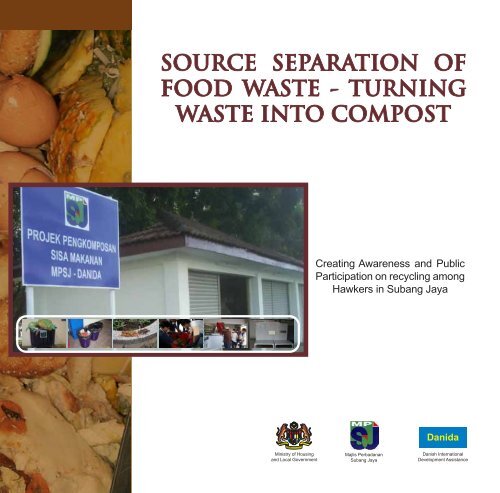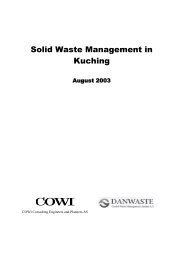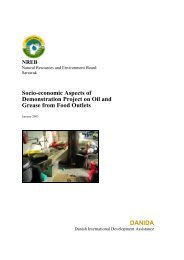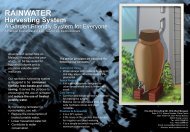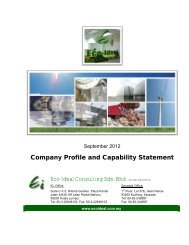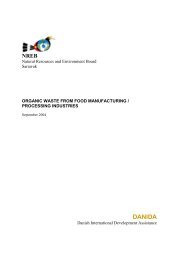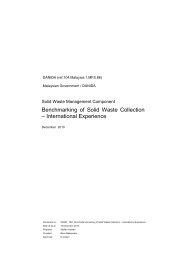source separation of food waste - turning waste into compost
source separation of food waste - turning waste into compost
source separation of food waste - turning waste into compost
Create successful ePaper yourself
Turn your PDF publications into a flip-book with our unique Google optimized e-Paper software.
SOURCE SEPARATION OF<br />
FOOD WASTE - TURNING<br />
WASTE INTO COMPOST<br />
Creating Awareness and Public<br />
Participation on recycling among<br />
Hawkers in Subang Jaya<br />
Majlis Perbadanan<br />
Subang Jaya
CARRIED OUT BY:<br />
Majlis Daerah Pekan, Pahang<br />
FUNDED BY:<br />
Solid Waste Management Component (SWMC)<br />
Community Initiative and Educational Fund<br />
DANIDA<br />
CONSULTANT (RESPONSIBLE ENTITY):<br />
Perunding Uras d.S<br />
AUTHOR:<br />
Eco-Ideal Consilting Sdn Bhd<br />
PUBLISHED BY:<br />
Department <strong>of</strong> National Solid Waste Management<br />
Ministry <strong>of</strong> Housing and Local Government<br />
Level 2 & 4, Block B North, Pusat Bandar Damansara<br />
50644 Kuala Lumpur, Malaysia<br />
Tel: +603 2092 4488<br />
Fax: +603 2093 5982<br />
www.kpkt.gov.my<br />
PRINTED BY:<br />
Meridian Solutions<br />
1st Edition<br />
December 2009<br />
1,000 Copies
Table <strong>of</strong> Contents<br />
Abbreviations and Acronyms<br />
i<br />
Foreword<br />
ii<br />
Message<br />
iii<br />
Background 1<br />
The Project Design and Implementation<br />
3<br />
Benefits, Challenges and Key Lessons Learnt 17<br />
Sustaining the Project 19
Abbreviations and Acronyms<br />
DANIDA<br />
JPSPN<br />
MARDI<br />
MHLG<br />
MPSJ<br />
NGOs<br />
NSP<br />
Danish International Development Assistance<br />
Jabatan Pengurusan Sisa Pepejal Negara<br />
(Department <strong>of</strong> National Solid Waste Management)<br />
Malaysian Agricultural Research and Development Institute<br />
Ministry <strong>of</strong> Housing and Local Government<br />
Majlis Perbandaran Subang Jaya (Subang Jaya Municipal Council)<br />
Non - Governmental Organisations<br />
National Strategic Plan<br />
i
Foreword<br />
Assalammualaikum and greetings,<br />
The <strong>food</strong> <strong>waste</strong> segregation programme for public <strong>food</strong> courts in Subang Jaya is one <strong>of</strong> the<br />
initiatives taken by Subang Jaya Municipal Council (MPSJ) to increase public participation<br />
in sustainable solid <strong>waste</strong> management. Food <strong>waste</strong> is the largest component <strong>of</strong> our solid<br />
<strong>waste</strong>. Achieving high recycling rates for our <strong>waste</strong> therefore, cannot be done without<br />
involving <strong>food</strong> <strong>waste</strong>. Making high quality recycled products from <strong>food</strong> <strong>waste</strong>, however,<br />
require segregation at <strong>source</strong> to avoid contamination <strong>of</strong> the materials. It is therefore,<br />
impossible to achieve high recycling rates without the active participation <strong>of</strong> the <strong>waste</strong><br />
generators which practically means all <strong>of</strong> us.<br />
Due to the flourishing eating-out culture in Malaysia, the council decided to establish a pilot programme for<br />
collection <strong>of</strong> <strong>food</strong> <strong>waste</strong> from selected <strong>food</strong> courts, i.e. USJ 7 Food Court, SS 13 Food Court, USJ SS 15 Food<br />
Court, PJS 11 Food Court and JUSCO Bandar Sunway Food Court. The hawkers were briefed and trained to<br />
segregate <strong>food</strong> <strong>waste</strong>s from the overall bulk <strong>of</strong> <strong>waste</strong> generated from their premises. Subsequently, the <strong>waste</strong>s<br />
were collected and brought to the Food Waste Composting Centre which the Council has established at USJ 1.<br />
After 6 months, 21 tonnes <strong>of</strong> <strong>food</strong> <strong>waste</strong> were collected and processed to <strong>compost</strong> before being used for<br />
landscaping at MPSJ areas.<br />
This programme is very successful. The support and commitment from the hawkers have been very encouraging.<br />
If we all work together, many more can be achieved. Based on the experience and achievements from this project,<br />
MPSJ is committed to continue and expand our effort in this field.<br />
It is our hope that other Local Authorities, associations, businesses, Non - Governmental Organisations (NGOs)<br />
and individuals may be able to use the experience learnt from this programme to enhance segregation <strong>of</strong> <strong>waste</strong> at<br />
<strong>source</strong> for recycling.<br />
I would like to extend my deepest thanks and appreciation to all parties involved in this project, especially the<br />
Danish International Development Assistance (DANIDA) who has assisted the Council in funding the programme,<br />
the Ministry <strong>of</strong> Housing and Local Government (MHLG), the Public Food Court Hawker Associations, JUSCO<br />
Bandar Sunway, the Resident Associations involved, the committed staff <strong>of</strong> the Council and those who were<br />
involved directly or indirectly in making this project a success.<br />
Thank You.<br />
Dato’ Adnan bin Hj. Md Ikshan<br />
Yang Dipertua<br />
SUBANG JAYA MUNICIPAL COUNCIL<br />
ii
Message<br />
Public participation and awareness are instrumental for improving the way we deal with our<br />
<strong>waste</strong> today. Waste reduction and recycling can only be successful if the authorities, the<br />
private sector and the public work together in unity for the better <strong>of</strong> the society.<br />
In 2005, the Government <strong>of</strong> Denmark through the Danish International Development<br />
Assistance (DANIDA) agreed with the Government <strong>of</strong> Malaysia to establish a fund to support<br />
Local Authorities, who were committed to carry out such initiatives to increase public participation<br />
and awareness in solid <strong>waste</strong> management on the local level.<br />
The fund was subsequently established in 2006, and the local authorities were requested to submit proposals for<br />
funding. The response from the Local Authorities was overwhelming and very encouraging. It was not easy for the<br />
Ministry and DANIDA to select the 10 initiatives, among the large number <strong>of</strong> interesting and promising ideas, which<br />
could be financed within the budgetary limits. The strong response is a clear demonstration <strong>of</strong> the commitment and<br />
enthusiasm towards saving re<strong>source</strong>s and protecting the environment that exists in many Local Authorities and<br />
communities.<br />
The initiatives selected include a very broad range <strong>of</strong> activities involving many parts <strong>of</strong> the society, including<br />
residents, school children, hotels, restaurants, hawkers, tourists to mention a few. And the ranges <strong>of</strong> subjects are<br />
similarly broad including <strong>waste</strong> reduction, recycling, home <strong>compost</strong>ing, bulky <strong>waste</strong> management and cleanliness.<br />
The fund has now come to an end, and it is time to sum up the experience and the lessons learned. Through a<br />
series <strong>of</strong> booklets, each initiative is presented and the experience and lessons learned are documented.<br />
It is my hope that the booklets will act as inspiration for others. The booklets are made not only to facilitate<br />
replication <strong>of</strong> the initiatives, but is also hoped that the booklets will inspire residents, communities and businesses<br />
to come up with different and new ideas to further increase the involvement <strong>of</strong> the society and the hope for a brighter<br />
future for all <strong>of</strong> us.<br />
The present booklet presents one <strong>of</strong> the successful community initiatives – Creating Awareness and<br />
Participation in Recycling among Hawkers in Subang Jaya.<br />
DATO’ NADZRI BIN YAHAYA, Ph.D<br />
Director General<br />
Department <strong>of</strong> National Solid Waste Management<br />
Ministry <strong>of</strong> Housing and Local Government<br />
iii
Background<br />
Municipal solid <strong>waste</strong> in Malaysia contains a high amount <strong>of</strong> organic matters, particularly <strong>food</strong> <strong>waste</strong>. The National<br />
Strategic Plan (NSP) for Solid Waste Management estimates that about 45% <strong>of</strong> the municipal <strong>waste</strong> are <strong>food</strong> <strong>waste</strong>,<br />
followed by other components such as papers, plastics, metals, etc. This figure has been reported 1 to reach even<br />
higher levels at nearly 70% when the <strong>waste</strong> arrives at the disposal site due to the <strong>separation</strong> <strong>of</strong> other recyclables<br />
from the <strong>waste</strong> and the lack <strong>of</strong> <strong>food</strong> <strong>waste</strong> recovery in Malaysia. Most <strong>food</strong> <strong>waste</strong> are disposed <strong>of</strong> at the disposal site.<br />
Food <strong>waste</strong> can be converted <strong>into</strong> useful materials such as soil conditioner or fertiliser if it is <strong>source</strong>-sorted and<br />
hereby, avoiding contamination from other <strong>waste</strong> materials. However, except some <strong>food</strong> <strong>waste</strong> collected from<br />
eateries by farmers for animal feed, <strong>source</strong> <strong>separation</strong> <strong>of</strong> <strong>food</strong> <strong>waste</strong> for recycling is not commonly practised in<br />
Malaysia due to various constraints. These constraints include low awareness among the <strong>waste</strong> generators and low<br />
demand <strong>of</strong> the products produced from the <strong>food</strong> <strong>waste</strong> such as the <strong>compost</strong>s.<br />
MPSJ has recognised the importance <strong>of</strong> promoting <strong>food</strong> <strong>waste</strong> recycling in order to increase the overall recycling<br />
rate, save re<strong>source</strong>s and divert solid <strong>waste</strong> from entering the disposal sites where it constitutes a financial burden<br />
and gives rise to environmental impacts.<br />
Due to the “eating-out” habits <strong>of</strong> Malaysians, significant amount <strong>of</strong> <strong>food</strong> <strong>waste</strong> are being generated from hawker<br />
centres. As an initiative to kick <strong>of</strong>f the <strong>food</strong> <strong>waste</strong> recycling activities in Subang Jaya, MPSJ decided to select<br />
hawker centres for a pilot project. Before the project, only a few hawkers segregated the <strong>food</strong> for collection by<br />
farmers, while most <strong>of</strong> the <strong>food</strong> <strong>waste</strong> were mixed and disposed <strong>of</strong> at Jeram landfill which is located approximately<br />
45km away from Subang Jaya.<br />
A total <strong>of</strong> 4 hawker centres with approximately 100 hawker stalls, estimated to generate about 500kg <strong>of</strong> <strong>food</strong> <strong>waste</strong><br />
daily, were selected for participation in the project.<br />
The project is a part <strong>of</strong> the Community Initiatives Programme initiated<br />
by the Department <strong>of</strong> National Solid Waste Management (JPSPN)<br />
and DANIDA. The programme supports initiatives on community<br />
participation in solid <strong>waste</strong> management in 10 Local Authorities<br />
around Peninsular Malaysia.<br />
This booklet aims to share the experiences gained from this Community<br />
Initiative project in MPSJ, including cost-benefit assessment <strong>of</strong> the<br />
selected setup <strong>of</strong> the <strong>food</strong> <strong>waste</strong> <strong>compost</strong>ing activities.<br />
1. Mohd Nazeri Salleh and Mohd Nasir Hassan (2005). Physical and Chemical Characteristics <strong>of</strong> Solid<br />
Waste Disposed at Taman Beringin Landfill, Kuala Lumpur. Faculty <strong>of</strong> Environmental Studies, Universiti<br />
Putra Malaysia (UPM).<br />
1
COMPOSTING AND ITS BENEFITS<br />
MPSJ chose <strong>compost</strong>ing as the method <strong>of</strong> recycling <strong>of</strong> the <strong>food</strong> <strong>waste</strong>.<br />
Composting is a process where the organic materials are transformed<br />
<strong>into</strong> <strong>compost</strong> via a process <strong>of</strong> controlled biological decomposition by<br />
microorganisms under the presence <strong>of</strong> oxygen. Alternatively,<br />
fermentation could have been selected. In such case, no oxygen is<br />
involved and biogas is produced in the addition to the <strong>compost</strong>.<br />
Like any other recycling methods, <strong>compost</strong>ing <strong>of</strong> <strong>food</strong> <strong>waste</strong>s, garden<br />
<strong>waste</strong>s and other organic <strong>waste</strong>s can help to reduce the amount <strong>of</strong> solid<br />
<strong>waste</strong>s for disposal, thereby, reducing the disposal costs, prolonging the<br />
lifespan <strong>of</strong> the disposal sites and minimising the environmental impacts.<br />
Food <strong>waste</strong> is the main contributor to greenhouse gas (methane)<br />
emission at landfills and is the main contributor to leachate formation due<br />
to the high humidity <strong>of</strong> the <strong>waste</strong>. It further contaminates other recyclables<br />
and complicates their <strong>separation</strong> from the <strong>waste</strong> stream. Compost is also<br />
a valuable product that can be used as fertiliser or soil conditioner in<br />
farming, gardening, parks and landscaping activities.<br />
Many <strong>compost</strong>ing techniques are available<br />
for converting the organic<br />
<strong>waste</strong> <strong>into</strong> <strong>compost</strong>. The advanced in-vessel, high speed <strong>compost</strong>ing<br />
method, using effective microorganisms s under controlled high<br />
temperature was chosen for this Community Initiative to ensure effective<br />
<strong>compost</strong>ing within the possible shortest period.<br />
KEY FACTS<br />
ABOUT<br />
COMPOSTING<br />
• Composting is an accelerated<br />
process <strong>of</strong> natural decomposition <strong>of</strong><br />
organic matters <strong>into</strong> <strong>compost</strong> by<br />
microorganisms, mainly bacteria<br />
and fungi under the presence<br />
<strong>of</strong> oxygen.<br />
• Compost is an organic material<br />
that can be used as soil conditioner<br />
(medium to grow plants) and fertilizer.<br />
• Compost contains nitrogen, phosphate,<br />
sulphur, potash and smaller<br />
but useful amounts <strong>of</strong> other minerals;<br />
all <strong>of</strong> which help to improve plant<br />
growth and yield.<br />
• Compost contains beneficial<br />
microorganisms that can suppress<br />
plant diseases and pests.<br />
• Compost can be used to remediate<br />
contaminated sites.<br />
2
The Project Design and Implementation<br />
In February 2008, MPSJ has proposed the project to MHLG for approval under the DANIDA financed Solid Waste<br />
Community Initiative Fund. The project was approved by the Fund in April 2008. The one-year project was<br />
commenced in May 2008 and completed in April 2009. The total budget for the initiative was RM 375,000 <strong>of</strong><br />
which RM180,000 was derived from the Community Initiatives Fund and RM195,000 from in-kind contributions<br />
from the MPSJ.<br />
The objectives <strong>of</strong> the project were:<br />
• To create awareness among the hawker centres on proper solid <strong>waste</strong> management<br />
• To encourage participation <strong>of</strong> the hawkers in solid <strong>waste</strong> management by segregating the <strong>waste</strong><br />
• To establish an effective collection <strong>of</strong> segregated <strong>food</strong> <strong>waste</strong> from the individual hawker stalls to a centralized<br />
<strong>compost</strong>ing facility<br />
• To turn the organic <strong>food</strong> <strong>waste</strong> <strong>into</strong> useful <strong>compost</strong><br />
• To gain experience in setting up such system and disseminate experience gained to others<br />
4 hawker centres in Subang Jaya with approximately 100 hawkers were selected:<br />
• Hawker Centre in USJ 7<br />
• Hawker Centre in PJS 11<br />
• Hawker Centre in SS 13<br />
• Hawker Centre in SS 15<br />
The selection was based on the expectation that 5kg <strong>food</strong> <strong>waste</strong> could be collected in average from each hawker<br />
daily. The 4 centres should therefore, be able to supply a total <strong>of</strong> 500kg <strong>of</strong> <strong>food</strong> <strong>waste</strong> every day.<br />
The project was carried out in 3 separate stages:<br />
1. Planning Stage – to decide which hawker centres to be involved; which <strong>compost</strong>ing technique to be applied;<br />
which capacity the <strong>compost</strong>ing facility should have; how to create awareness; how much budget is required;<br />
how to set up the taskforce and to conduct pre-visits to the selected hawker centres to determine location <strong>of</strong> bins, etc.<br />
2. Implementation – to implement the planned activities; set-up the <strong>compost</strong>ing facility; carry out awareness<br />
creation; undertake trial run and actual operation <strong>of</strong> the collection system, conduct data collection, etc.<br />
3. Monitoring/Evaluation – to monitor, conduct post project surveys, analyse and assess the findings.<br />
3
The process plan <strong>of</strong> the entire design <strong>of</strong> the community Initiative Project is as shown below:<br />
Prepare and submit Project<br />
Proposal to MHLG<br />
Approved Project Proposed by<br />
MHLG and Secured Funding from<br />
DANIDA- Community Initiatives<br />
Establish a Taskforce Commitee<br />
Prepare<br />
Awareness-<br />
Creation<br />
Set Up <strong>of</strong> Food<br />
Waste Composting<br />
Facility<br />
Separate and Collect Food Waste<br />
at Hawker Centres<br />
Transfer Food Waste to Food<br />
Waste Composting Facility<br />
Produce Compost or Soil<br />
Conduct Survey<br />
Evaluate and Review Results for<br />
Replication<br />
PROJECT IMPLEMENTATION FLOW<br />
4
PLANNING<br />
ESTABLISHING A TASKFORCE<br />
Led by MPSJ, a taskforce was established on 27 May 2008 comprising <strong>of</strong> representatives from the participating hawker<br />
centres, resident associations and the <strong>waste</strong> contractors. The taskforce served as a platform for planning, coordination<br />
and decision making for the project. Taskforce meetings were held periodically throughout the project duration to discuss<br />
any issues <strong>of</strong> concern and to decide on corrective action required to ensure effective implementation <strong>of</strong> the project.<br />
CREATING AWARENESS<br />
Hawker centres were targeted as <strong>waste</strong> generators for this initiative.<br />
As awareness is crucial for motivating the hawkers to segregate<br />
their <strong>food</strong> <strong>waste</strong> as part <strong>of</strong> their daily routines, it was vital to work<br />
closely with the hawkers from the beginning <strong>of</strong> the project.<br />
To achieve this, MPSJ conducted briefing sessions about the project<br />
at all respective hawker centres. The briefing included explanation<br />
on the project objectives, the benefits <strong>of</strong> the project and the<br />
expectations on the participation <strong>of</strong> the hawkers to segregate their<br />
<strong>food</strong> <strong>waste</strong>.<br />
In addition to the talks conducted at the respective hawker centres,<br />
another awareness talk was conducted at MPSJ <strong>of</strong>fice. The event<br />
was attended by a total <strong>of</strong> 33 hawkers from the 4 selected<br />
hawker-centres. The hawkers reacted enthusiasticly towards the<br />
project and agreed to participate. A briefing was also given at the<br />
<strong>compost</strong>ing facility to show the actual <strong>compost</strong>ing process to the<br />
participating hawkers.<br />
Educational pamphlets were prepared by MPSJ and distributed<br />
during the talk. The pamphlets served as an educational tool and as<br />
a reference to the hawkers about the project implementation.<br />
STAKEHOLDERS<br />
& THEIR ROLES<br />
MPSJ<br />
• Coordinates and monitors the overall<br />
implementation <strong>of</strong> the project<br />
• Chairs the taskforce committee and ensures that all<br />
inputs from the stakeholders are included in the<br />
decision-making<br />
• Establishes recording <strong>of</strong> segregated <strong>food</strong> <strong>waste</strong><br />
throughout the duration <strong>of</strong> the project<br />
• Operates the <strong>compost</strong>ing centre<br />
• Prepares and submits progress reports to DANIDA<br />
• Documents the implementation throughout the project<br />
for dissemination<br />
HAWKERS<br />
• Participate actively in the project by segregating the<br />
<strong>food</strong> <strong>waste</strong>s at <strong>source</strong>, following the instructions given<br />
RESIDENT ASSOCIATIONS<br />
• Informs the nearby residents about the <strong>food</strong> <strong>waste</strong><br />
<strong>compost</strong>ing initiative<br />
• Assists MPSJ in creating awareness and disseminaing<br />
the awareness materials (brochures) about the project<br />
WASTE CONTRACTOR<br />
• Collects segregated <strong>food</strong> <strong>waste</strong>s from the participating<br />
hawker centers and send to the centralised<br />
<strong>compost</strong>ing facility<br />
5
SETTING UP OF FOOD WASTE SEPARATION<br />
AND COMPOSTING FACILITIES<br />
The selection <strong>of</strong> hawker centres for the project was proposed by MPSJ<br />
and endorsed by the taskforce. The selection was made based on logistic<br />
considerations, especially the distance between the centres to ease the collection<br />
and distance to the <strong>compost</strong>ing site.<br />
Each hawker centre was visited to find the right place for the 30-litre <strong>food</strong> <strong>waste</strong> bins<br />
at each individual hawker stall. The visit was also aimed to find the location to place<br />
the 1,000-litre communal bin where the <strong>food</strong> <strong>waste</strong> from individual bins shall be<br />
transferred by the hawkers.<br />
• Waste Bin at Individual Hawker Stall<br />
Individual <strong>waste</strong> bins and communal bins were subsequently procured and placed<br />
at the respective hawker centres. A collection schedule for the <strong>food</strong> <strong>waste</strong> at each<br />
hawker centre was also determined. The <strong>food</strong> <strong>waste</strong> was transferred from the<br />
individual stalls to the communal bin by the individual hawkers. Transfer <strong>of</strong> the <strong>food</strong><br />
<strong>waste</strong> from the communal bin to the <strong>compost</strong>ing facility was done by the appointed<br />
<strong>waste</strong> contractor on the next morning before the operation <strong>of</strong> the hawker<br />
centre started.<br />
• Communal Waste Bin<br />
The taskforce decided to locate the <strong>compost</strong>ing facility at an existing <strong>waste</strong> storage area in USJ 1/33 at Subang<br />
Jaya. Advanced in-vessel high-speed <strong>compost</strong>ing technology using effective microorganism at high temperature<br />
was opted for the project instead <strong>of</strong> conventional <strong>compost</strong>ing. The in-vessel high-speed <strong>compost</strong>ing system was<br />
deemed appropriate for this project because it requires very little space and is able to produce <strong>compost</strong> within very<br />
short duration (24-48 hours).<br />
Besides this, the system has better control <strong>of</strong> bad odour and requires<br />
only minimal labour. All these are factors that suit the requirements in<br />
urban areas such as MPSJ. The <strong>compost</strong>ing facility is a small<br />
40-metre square ro<strong>of</strong>ed structure with electricity and water supply,<br />
a requirement for the <strong>compost</strong>ing machines. The facility was equipped<br />
with 2 units <strong>of</strong> in-vessel <strong>compost</strong>ing machines, each with a capacity <strong>of</strong><br />
250kg/day and has additional space for the preparation <strong>of</strong> <strong>food</strong> <strong>waste</strong><br />
before feeding <strong>into</strong> the machines.<br />
6<br />
• In Vessel Composting machine
IMPLEMENTATION<br />
TRIAL RUN<br />
A one-month trial run <strong>of</strong> the system was conducted on 1 November 2008. The main objective <strong>of</strong> the trial run<br />
was to identify any part <strong>of</strong> the system that would require corrective measures to ensure effective operation <strong>of</strong><br />
the system.<br />
On 7 November 2008, another round <strong>of</strong> awareness talks was conducted at each hawker centre. The talks were,<br />
however, attended by only 15 hawkers.<br />
Posters were put up at the hawker centres to provide further guidance to the hawkers on the step–by-step process<br />
<strong>of</strong> segregation, collection and <strong>compost</strong>ing.<br />
During the trial period, some challenges were realised:<br />
• One complaint was received from a shop, neighbouring the<br />
<strong>compost</strong>ing facility about bad odour from the facility.<br />
• Oil and grease were discharged from the <strong>compost</strong>ing machines to<br />
the drains.<br />
• Some <strong>of</strong> the <strong>food</strong> <strong>waste</strong> received at the <strong>compost</strong>ing facility were<br />
still mixed with non-<strong>food</strong> <strong>waste</strong> materials such as straws, spoons<br />
and plastic bags.<br />
• Smaller amounts <strong>of</strong> <strong>food</strong> <strong>waste</strong> was collected from the selected<br />
hawker centres than expected. It was recorded that the <strong>waste</strong><br />
received during the trial run was only about 50kg/day as<br />
compared to the expected 500kg/day. This was mainly due to<br />
the overestimation <strong>of</strong> the amount <strong>of</strong> <strong>food</strong> <strong>waste</strong> as well as low<br />
participation from the hawkers.<br />
As a response to the findings from the trial period, the taskforce<br />
subsequently took the following actions to overcome the challenges:<br />
• Cleaning and washing <strong>of</strong> the <strong>compost</strong>ing facility after each batch <strong>of</strong> <strong>food</strong> <strong>waste</strong> was loaded <strong>into</strong> the<br />
machines was introduced to ensure cleanliness and to avoid bad odour.<br />
• A simple process <strong>of</strong> manual drainage <strong>of</strong> excess water from the <strong>food</strong> <strong>waste</strong> buckets before loading it to the<br />
<strong>compost</strong>ing machine was introduced at the <strong>compost</strong>ing facility to improve the structure <strong>of</strong> the <strong>waste</strong> and<br />
avoid discharge <strong>of</strong> oil and grease from the machines.<br />
7
• A simple sorting process was introduced at the <strong>compost</strong>ing facility for the workers to pick up any non-<strong>food</strong><br />
<strong>waste</strong> from the received <strong>food</strong> <strong>waste</strong> before loading it to the <strong>compost</strong>ing machine. This process is important to<br />
prevent damage to the <strong>compost</strong>ing machines and to ensure the quality <strong>of</strong> the <strong>compost</strong>.<br />
• Oil and grease traps with screen were established at the <strong>compost</strong>ing facility to avoid the <strong>food</strong> residues and the<br />
oil and grease generated during the sorting <strong>of</strong> the <strong>food</strong> <strong>waste</strong> from entering the drains. This prevented the bad<br />
odour caused by <strong>food</strong> residues and oil and grease trapped in the drain from reoccurring.<br />
• Follow-up awareness talks to the hawker centres were conducted to increase participation.<br />
• Simple sorting <strong>of</strong> <strong>food</strong> <strong>waste</strong> before loading <strong>into</strong> the machines<br />
• Cleaning after Operation<br />
• Composting facility at USJ1<br />
8<br />
• Grease Trap Installed at the Site
OPERATION OF THE FOOD WASTE SYSTEM<br />
Full scale operation <strong>of</strong> the <strong>food</strong> <strong>waste</strong> system was commenced after one month <strong>of</strong> trial run and after all the corrective<br />
measures had been implemented. The <strong>compost</strong>ing machines were able to treat a maximum <strong>of</strong> 500kg <strong>food</strong> <strong>waste</strong>s each day.<br />
The segregation <strong>of</strong> <strong>food</strong> <strong>waste</strong> at the hawker centres took place all day from the morning when the hawkers started to<br />
prepare the <strong>food</strong>. More <strong>food</strong> <strong>waste</strong> were generated throughout the day, mainly from the <strong>food</strong> residues left by the customers.<br />
The hawkers transferred the <strong>food</strong> <strong>waste</strong> to the communal bin whenever the individual bins were full. Since the operation<br />
<strong>of</strong> most <strong>of</strong> the participating hawker centres continued through the evening, the collection <strong>of</strong> <strong>food</strong> <strong>waste</strong> from the<br />
communal bin was only done early in the next morning, before operation <strong>of</strong> the centre started.<br />
The <strong>waste</strong> contractor emptied the communal bin from all participating hawker centres in one trip to save transportation<br />
cost and delivered the collected <strong>food</strong> <strong>waste</strong> to the <strong>compost</strong>ing facility at around 10.00am. Once the <strong>food</strong> <strong>waste</strong> arrived at<br />
the facility, the workers would drain excess water from the <strong>food</strong> <strong>waste</strong> and carry out simple sorting <strong>of</strong> the <strong>waste</strong> to pick<br />
up any non-<strong>food</strong> items before the <strong>waste</strong> were loaded <strong>into</strong> the <strong>compost</strong>ing machines.<br />
Sawdust was added to the <strong>compost</strong>ing process as bulking agent in order to improve the structure and the <strong>compost</strong>ing<br />
process. Approximately 1kg <strong>of</strong> saw dust was added to every 5kg <strong>of</strong> raw <strong>food</strong> <strong>waste</strong>.<br />
The machines processed the <strong>waste</strong> automatically under high temperature (60-70 degree Celsius) with the help <strong>of</strong><br />
effective microorganisms added to the machine and transformed it <strong>into</strong> useful <strong>compost</strong> after 24-48 hours. As the <strong>compost</strong><br />
quality after 48 hours was found to be better in terms <strong>of</strong> moisture content and maturity <strong>of</strong> operation, decision was made<br />
to process the <strong>waste</strong> for 24 hours only on Monday-Friday and process the <strong>food</strong> <strong>waste</strong> arriving on Saturday for additional<br />
24 hours over Sunday when the hawker centres were not in operation.<br />
• Loading the <strong>waste</strong> <strong>into</strong> the Machine<br />
• Quality <strong>of</strong> <strong>compost</strong> produced<br />
9
USE OF COMPOST FROM FOOD WASTE<br />
The <strong>compost</strong> produced was used by the Landscape Department <strong>of</strong> MPSJ for maintaining their parks and landscapes.<br />
Apart from internal use, MPSJ also packed the <strong>compost</strong>s and distributed it for free to the participating hawkers as an<br />
incentive as well as distributed to the public during road shows and promotional programmes.<br />
• The <strong>compost</strong> produced from the <strong>food</strong> <strong>waste</strong> (left) and application for gardening / flowering by the MPSJ Landscape Department (right)<br />
The overall workflow <strong>of</strong> the operation is illustrated as below:<br />
Compost returns to nature as<br />
nutrients for plant growth and yield<br />
which in turn, are used as raw<br />
ingredients in <strong>food</strong> preparation<br />
Hawkers generate <strong>food</strong><br />
<strong>waste</strong> from <strong>food</strong><br />
preparation and consumption<br />
MPSJ uses the <strong>compost</strong> for<br />
parks and landscapes and<br />
distributes it to the hawkers<br />
for gardening<br />
Hawkers separate<br />
<strong>food</strong> <strong>waste</strong> and<br />
dispose <strong>of</strong> it <strong>into</strong><br />
special <strong>waste</strong> bins<br />
Composting machine<br />
processes the <strong>food</strong><br />
<strong>waste</strong> <strong>into</strong> <strong>compost</strong><br />
within 24-48 hours<br />
Contractor collects<br />
and transports the<br />
<strong>food</strong> <strong>waste</strong> to USJ 1<br />
Composting Facility<br />
Hawkers transfer their<br />
<strong>food</strong> <strong>waste</strong> to a<br />
communal <strong>waste</strong> bin<br />
THE OVERALL OPERATION OF THE COMPOSTING PROGRAMME<br />
10
OUTREACH AND PROMOTIONAL ACTIVITIES<br />
To increase the participation <strong>of</strong> the hawkers in the <strong>food</strong> <strong>waste</strong> segregation, MPSJ has organised a series <strong>of</strong> site<br />
visits to the <strong>compost</strong>ing facility for the representatives <strong>of</strong> USJ 7 and SS 13 hawker centres. The visits enabled the<br />
hawkers to fully understand the system and the outcome <strong>of</strong> their efforts to segregate <strong>food</strong> <strong>waste</strong> at <strong>source</strong>. To<br />
recognise the hawkers’ contributions to the project, <strong>compost</strong> was distributed to the hawkers as a reward.<br />
Furthermore, MPSJ organised a special open-day event at the <strong>compost</strong>ing facility in conjunction with the “Recycling<br />
and Environment Day” celebration on 8 July 2009. The event was opened for all and was attended by both the<br />
public and the hawkers who have participated in the community initiative project. During the opening ceremony, the<br />
Mayor <strong>of</strong> MPSJ has explained the problems <strong>of</strong> traditional <strong>food</strong> <strong>waste</strong> disposal at disposal sites and highlighted the<br />
objectives <strong>of</strong> the community initiative project <strong>turning</strong> <strong>food</strong> <strong>waste</strong> <strong>into</strong> useful re<strong>source</strong>s.<br />
MPSJ also produced a video on the project to provide visualised information to any interested party on<br />
<strong>compost</strong>ing <strong>of</strong> <strong>food</strong> <strong>waste</strong>. The video showcases the various stages <strong>of</strong> the project starting from segregation,<br />
transportation, screening and processing <strong>of</strong> <strong>food</strong> <strong>waste</strong> until packaging and usage <strong>of</strong> the <strong>compost</strong>s. In addition, a<br />
website was also created to publicise the project, to maintain the on-going support from the hawkers as well as to<br />
disseminate experience learnt about <strong>compost</strong>ing <strong>of</strong> <strong>food</strong> <strong>waste</strong>.<br />
11
MONITORING AND EVALUATION<br />
PARTICIPATION OF HAWKERS<br />
As described above, the participation <strong>of</strong> the hawkers was observed to be rather low during the trial period. After the<br />
trial period, the task force therefore, has carried out the described series <strong>of</strong> awareness activities to encourage the<br />
participation <strong>of</strong> hawkers.<br />
The face - to-face visits to the hawkers and the visit by hawkers to the <strong>compost</strong>ing facility were found to be most<br />
effective. The distribution <strong>of</strong> final <strong>compost</strong> to the hawkers was also very successful. It clearly demonstrated the<br />
value and outcome <strong>of</strong> their efforts to them.<br />
The efforts were rewarded with a considerable increase in participation from the hawkers. The increase in <strong>food</strong><br />
<strong>waste</strong> collected from the 4 hawker centres, especially over the last 2 months <strong>of</strong> the pilot project period (graph below)<br />
is a concrete indication <strong>of</strong> the improved participation rate. This indicates that the continuous awareness and<br />
outreach programmes were effective in encouraging more participation.<br />
The achieved participation <strong>of</strong> hawkers in the segregation <strong>of</strong> <strong>food</strong> <strong>waste</strong> was one <strong>of</strong> the most important successes<br />
<strong>of</strong> this pilot project.<br />
AMOUNT OF WASTE COLLECTED (Kg/ Month)<br />
3000<br />
2500<br />
2000<br />
1500<br />
1000<br />
500<br />
0<br />
AMOUNT OF FOOD WASTE<br />
COLLECTED (Kg/ Month) FROM 4 HAWKERS (NOV 08 - APR 09)<br />
Nov 08 Dec 08 Jan 09 Feb 09 March 09 Apr 09<br />
MONTHS<br />
Amount <strong>of</strong> Food Waste Collected at the selected 4 hawker centres<br />
12
QUESTIONNAIRE SURVEY<br />
A questionnaire survey on the participation <strong>of</strong> the hawkers was carried out by MPSJ after 6 months <strong>of</strong> operation to<br />
assess the effectiveness <strong>of</strong> the project. A total <strong>of</strong> 26 hawkers from the 4 participating hawker centres were selected<br />
on a random basis for the survey. The survey gave insight in the hawkers’ ideas on <strong>food</strong> <strong>waste</strong> segregation and<br />
<strong>compost</strong>ing and provided information to MPSJ on further awareness activities required if the project were to be<br />
replicated to other potential hawker centres.<br />
The survey showed that 77% <strong>of</strong> the respondents or 21 hawkers have attended the awareness briefings organised<br />
by MPSJ. Many hawkers claimed that they have benefited from these talks, gaining better understanding <strong>of</strong><br />
<strong>compost</strong>ing and its benefits to the environment.<br />
92% <strong>of</strong> the hawkers interviewed believed that <strong>food</strong> <strong>waste</strong> <strong>separation</strong> at <strong>source</strong> and <strong>compost</strong>ing are beneficial to the<br />
environment. nment. They expressed that the segregation was not considered a burden to them because the selected<br />
method <strong>of</strong> <strong>food</strong> <strong>waste</strong> segregation was easy to follow. The hawkers also showed positive feedback and high interest<br />
in the <strong>compost</strong>s produced from the segregated <strong>food</strong> <strong>waste</strong>.<br />
The survey documented the reasons for the hawkers to participate in the initiative as illustrated in chart below:<br />
14<br />
OTHER<br />
REASON<br />
29<br />
INFLUENCED<br />
BY OTHER<br />
43<br />
ENVIRONMENTAL<br />
PURPOSE<br />
14<br />
WASTE<br />
REDUCTION<br />
Reasons for Participating by Hawkers in Composting in Subang Jaya (in Percentage <strong>of</strong> Respondents)<br />
13
COLLECTION OF FOOD WASTE AND PRODUCTION OF COMPOST<br />
During the period from November 2008 to February 2009, the volume <strong>of</strong> <strong>food</strong> <strong>waste</strong> collected from the hawker centres<br />
became a concern to the project. 6 tonnes <strong>of</strong> <strong>food</strong> <strong>waste</strong> or around 50 kg/day were received. Over-estimation <strong>of</strong> the <strong>food</strong><br />
<strong>waste</strong> generation at the hawker centres proved to be the main reason for the low collection rate. It was found that some<br />
hawker stalls were not in operation and some did not generate any significant amount <strong>of</strong> <strong>food</strong> <strong>waste</strong> as they are only<br />
selling beverages. Increase in participation from the hawkers would therefore, not be sufficient to fully utilise the capacity<br />
<strong>of</strong> the <strong>compost</strong>ing machines.<br />
In addition to the continuous efforts to increase participation from the hawkers, the taskforce therefore, decided to include<br />
<strong>food</strong> <strong>waste</strong> from other <strong>source</strong>s. MPSJ approached the hypermart (Jusco Bandar Sunway) in view that the <strong>food</strong> courts in<br />
the hypermart generate significant amount <strong>of</strong> <strong>food</strong> <strong>waste</strong> every day. Jusco Bandar Sunway was positive towards<br />
participating and bins were subsequently provided to them by MPSJ. The involvement <strong>of</strong> the hypermart in the project<br />
from March 2009 has significantly increased the <strong>food</strong> <strong>waste</strong> amount received, reaching about 90% to 100% <strong>of</strong> the<br />
capacity <strong>of</strong> the <strong>compost</strong>ing machines from March and April 2009.<br />
Since the operation <strong>of</strong> the <strong>food</strong> <strong>waste</strong> <strong>compost</strong>ing facility from November 2008 until April 2009, a total <strong>of</strong> 21 tonnes <strong>of</strong><br />
<strong>food</strong> <strong>waste</strong> have been collected from the 4 hawker centres and Jusco Bandar Sunway, resulting in about 15 tonnes<br />
(including saw dust input) <strong>of</strong> <strong>compost</strong>s being produced (see graph below). The volume <strong>of</strong> <strong>food</strong> <strong>waste</strong> was on average,<br />
reduced by approximately 50% after the <strong>compost</strong>ing process.<br />
AMOUNT (Tonnes)<br />
9000<br />
8000<br />
7000<br />
6000<br />
5000<br />
4000<br />
3000<br />
2000<br />
1000<br />
0<br />
Nov Dec Jan Feb Mac Apr<br />
PERIOD<br />
FOOD WASTE COLLECTED<br />
COMPOST PRODUCED<br />
Volume <strong>of</strong> Food Waste Collected and Compost Produced, November 2008 - April 2009<br />
14
QUALITY OF THE COMPOST<br />
Samples <strong>of</strong> the <strong>compost</strong> produced were tested at a laboratory. The nutrient content appeared to be good, with high levels<br />
<strong>of</strong> nitrogen, phosphate and calcium oxide as compared to typical <strong>compost</strong> (summarised in table below). It is an<br />
indication that the <strong>compost</strong> may be used as fertilizer supplement in addition to the use as soil-conditioner for landscaping<br />
and gardening.<br />
Nitrogen (N) Potash (K2O) Phosphate (P2O6) Magnesium Oxide (MgO) Calcium oxide (CaO)<br />
1.95 0.66 1.12 0.11 1.56<br />
Nutrient Content <strong>of</strong> MPSJ’s Compost<br />
ASSESSMENT OF COST AND BENEFITS<br />
An assessment <strong>of</strong> the cost and revenue <strong>of</strong> the project was carried out towards the completion <strong>of</strong> this pilot project.<br />
The details <strong>of</strong> the capital expenditure, operating expenditure and revenue (cost savings) are outlined in the table below.<br />
The major capital outlay for the project was the 2 high-speed <strong>compost</strong>ing machines.<br />
The major operating expenses were electricity and the transport cost from the hawker centres to the <strong>compost</strong>ing facility.<br />
The main cost savings were savings on transportation costs for <strong>waste</strong> to disposal, landfill tipping fees and the savings<br />
from purchasing chemical fertilisers.<br />
Cost-Benefit Analysis <strong>of</strong> MPSJ’s Community Food Waste Composting Project,<br />
November 2008 to April 2009<br />
Project Costs Unit Total<br />
A) Total Capital Costs 2 machines <strong>of</strong> 250kg capacity each RM156,800.00<br />
Grease trap<br />
RM3,500.00<br />
Bins for collection<br />
RM6,600.00<br />
Operational Costs<br />
1) Electricity RM1,428.81 X 6 month RM8,572.90<br />
2) Water RM40.30 X 6 month RM241.80<br />
3) Usage <strong>of</strong> Microbe RM500.00 X 4 times RM2,000.00<br />
4) Contractor Service RM1,300.00 X 6 month RM7,800.00<br />
B) Total operational costs RM18,614.70<br />
C) Indirect Costs<br />
1) MPSJ Workers Insignificant Insignificant<br />
2) Packaging Costs Insignificant Insignificant<br />
Note: a) Electricity and water consumptions are based on actual bills<br />
b) Assumption to top up microbe 2 times over 6 months <strong>of</strong> 1kg for each machine<br />
15
Project Benefits Unit Total<br />
A) Cost Savings<br />
1) Waste Tipping Fees RM45.00 X 20.8 tonnes RM935.00<br />
2) Waste Collection Costs RM1,950.00 X 6 month RM11,700.00<br />
3) Cost <strong>of</strong> Compost RM500.00 X 14.9 tonnes RM7,450.00<br />
Total<br />
RM20,085.00<br />
Indirect Benefits<br />
1) Saving <strong>of</strong> Environmental<br />
Damage cost<br />
- Contamination <strong>of</strong> Land<br />
- Leachate Treatment Cost Not Accounted<br />
Not Accounted<br />
- Human Health Risk<br />
- Greenhouse Gases Emission<br />
2) Creation <strong>of</strong> Awareness<br />
- Among the Hawkers<br />
Not Accounted<br />
Not Accounted<br />
Note: a) The <strong>waste</strong> collection fee is assumed to be 50% more as compared to the collection done to bring the <strong>waste</strong> to the<br />
<strong>compost</strong>ing site due to the travelling distances (normal disposal to Jeram Landfill)<br />
b) The tipping fee refers to the gate fee <strong>of</strong> entering Jeram Landfill<br />
c) The cost <strong>of</strong> typical <strong>compost</strong> used here was provided by MBSJ based on current market price for <strong>compost</strong> <strong>of</strong> lower<br />
fertilising value. Thus, the actual value <strong>of</strong> the <strong>food</strong> <strong>waste</strong> derived <strong>compost</strong> is expected to be higher. The savings <strong>of</strong><br />
chemical fertiliser which is in used now is also not accounted for here.<br />
From a commercial point <strong>of</strong> view, the high capital and operating cost for the selected technically advanced in-vessel<br />
high-speed solution renders the system economically non-viable. However, the system may still require lower financial<br />
support than the alternative collection and disposal costs for traditional <strong>waste</strong> disposal, implying that the solution still may<br />
constitute an economically attractive option for the solid <strong>waste</strong> management system. The costs may further be reduced<br />
in the future. The main operating costs for the system were the electricity consumption and the transportation cost. These<br />
costs might be reduced with the improvement <strong>of</strong> energy efficiency as well as the optimisation <strong>of</strong> transportation <strong>of</strong> <strong>waste</strong>.<br />
The selected in-vessel high-speed <strong>compost</strong>ing process allows very short <strong>compost</strong>ing time and very small land<br />
requirements and is therefore, suitable for congested areas where space constraint is a major barrier. In most cases<br />
where reasonable access to space is possible, traditional <strong>compost</strong>ing techniques with less capital and operating costs<br />
would probably be applied.<br />
16
Benefits, Challenges and Key Lessons Learnt<br />
BENEFITS<br />
The main impact <strong>of</strong> this project is the documentation that awareness among hawkers on the need for <strong>source</strong><br />
segregation and recycling can easily be established. This is a very important and very positive message for all<br />
future recycling initiatives, targeting small scale businesses.<br />
The participants were not only made aware <strong>of</strong> the potential <strong>of</strong> <strong>waste</strong> recycling, but also experienced it hands-on<br />
through the participation in the process. Evidently, the steady increase <strong>of</strong> <strong>food</strong> <strong>waste</strong> received from the hawker<br />
centres correlates to the level <strong>of</strong> awareness and support from the hawkers.<br />
The environmental benefits include:<br />
• Avoided environmental degradation by the reduced use <strong>of</strong> landfill space, reduced greenhouse gas emission<br />
and leachate formation, reduced human health risk and so forth.<br />
• The use <strong>of</strong> <strong>compost</strong> reduces the usage <strong>of</strong> chemical fertiliser which saves re<strong>source</strong>s and further reduces<br />
environmental degradation.<br />
Overall, the initiative has been very successful. As the first community initiative to turn hawker <strong>food</strong> <strong>waste</strong> <strong>into</strong> useful<br />
<strong>compost</strong>, the project has already recorded success in demonstrating that such system can be applied and that<br />
strong support and participation from the hawkers and other stakeholders may be established.<br />
However, as indicated above, the decision on the technical design <strong>of</strong> such system should also consider the different<br />
technology options that would influence the costs and revenues <strong>of</strong> the system.<br />
17
CHALLENGES AND KEY LESSONS LEARNT<br />
The project has overcome a number <strong>of</strong> challenges. They are discussed as follow:<br />
• INCENTIVES TO INCULCATE FOOD WASTE SEGREGATION AT SOURCE<br />
Segregation <strong>of</strong> <strong>food</strong> <strong>waste</strong> to become a routine for the hawkers is crucial for the success <strong>of</strong> the project. Besides<br />
organising awareness activities to stir interest, possible incentives may be awarded to ensure participation. Giving<br />
away free <strong>compost</strong> and gardening kits to participating hawkers can be an effective way <strong>of</strong> sustaining their interest<br />
in practising <strong>food</strong> <strong>waste</strong> segregation and encouraging them to practise gardening, towards healthy lifestyle.<br />
• SCREENING AND PROCESSING OF FOOD WASTE<br />
During the operation, some <strong>food</strong> <strong>waste</strong>s received at the <strong>compost</strong>ing facility were found to be mixed with non-<strong>food</strong><br />
<strong>waste</strong> materials such as fork and spoons, straws, chopsticks, etc. By simple screening processes, it has been<br />
possible to manually sort out these materials. Further, it was found that the <strong>food</strong> <strong>waste</strong> contains very high moisture<br />
and oil content. It is therefore, recommended that the <strong>food</strong> <strong>waste</strong>s should be drained before being fed in to the<br />
<strong>compost</strong>ing machines to reduce the liquid load to the machines. Oil and grease trap should be installed to cater for<br />
the water drained <strong>of</strong>.<br />
According to the machine’s specification, <strong>food</strong> <strong>waste</strong> can be processed <strong>into</strong> <strong>compost</strong> within 24 to 48 hours<br />
depending on the <strong>waste</strong> composition. However, the actual operation shows that 48 hours is the optimum process<br />
duration for producing better qualities <strong>of</strong> more matured <strong>compost</strong>s.<br />
• ALTERNATIVE METHOD FOR COMPOSTING<br />
In this project, the <strong>compost</strong>ing was done using advanced in-vessel high-speed <strong>compost</strong>ing machine which utilises<br />
mechanical <strong>turning</strong> and temperature control. This method requires very short time to achieve <strong>compost</strong>ing but it<br />
requires high investment and operating costs, i.e. energy (electricity). There are other alternatives available which<br />
can be considered such as conventional windrow, aerated chamber <strong>compost</strong>ing and bin <strong>compost</strong>ing methods.<br />
These conventional methods imply less capital costs and consume less energy. They do, however, require longer<br />
<strong>compost</strong>ing period and have larger land requirements. Windrow <strong>compost</strong>ing in particular, requires large space or<br />
land to carry out the <strong>compost</strong>ing process. Detailed comparison <strong>of</strong> the pros and cons <strong>of</strong> these alternative<br />
<strong>compost</strong>ing methods will depend on the local conditions.<br />
18
Sustaining the Project<br />
MPSJ is determined to sustain the initiative and replicate the <strong>food</strong> <strong>waste</strong> <strong>compost</strong>ing system for other hawker<br />
centres. Several activities have been carried out by MPSJ to provide the groundwork for replication:<br />
• RESEARCH AND DEVELOPMENT – MPSJ has performed laboratory analyses <strong>of</strong> the <strong>compost</strong> quality and<br />
is currently collaborating with Malaysian Agricultural Research and Development Institute (MARDI) to enhance<br />
the quality <strong>of</strong> the <strong>compost</strong>s as well as to undertake other research concerning the <strong>compost</strong> products.<br />
• PROMOTION FOR THE COMPOST – MPSJ plans to promote and commercialise the <strong>compost</strong> to the public,<br />
hoping that it will create public awareness about <strong>compost</strong>ing <strong>of</strong> <strong>food</strong> <strong>waste</strong>. The <strong>compost</strong>s can be used as<br />
fertiliser or soil conditioner depending on the quality.<br />
• GUIDANCE FOR COMPOSTING – MPSJ plans to provide information and guidance to the public through mass<br />
media and by initiating a special website dedicated for <strong>compost</strong>ing. The website will introduce the public to<br />
various methods <strong>of</strong> <strong>compost</strong>ing and teach them on how to do <strong>compost</strong>ing at home.<br />
• ESTABLISH A COMPOSTING CENTRE FOR THE PUBLIC – MPSJ also plans to establish a <strong>compost</strong>ing<br />
facility which is open to accept <strong>food</strong> <strong>waste</strong> from the public. This is mainly aimed to create awareness and<br />
encourage the public to drop <strong>of</strong>f their <strong>food</strong> <strong>waste</strong> to the <strong>compost</strong>ing facility.<br />
In case the revenue gained from the <strong>compost</strong> produced by MPSJ is not enough to sustain and expand the<br />
<strong>compost</strong>ing system, MPSJ is committed to support the operations by providing manpower and financial support for<br />
the purchase <strong>of</strong> the microbes for the <strong>compost</strong>ing process, maintenance <strong>of</strong> the <strong>compost</strong>ing machines and paying for<br />
the electricity and water bills, etc.<br />
As a long term sustainability plan, MPSJ is planning to construct a centralised recycling centre on a 2-acre land<br />
at Lot PT 300, Subang Jaya. The proposed plan will integrate the existing <strong>compost</strong>ing facility at USJ 1. More<br />
<strong>compost</strong>ing machines may be set-up at the new site to recycle more <strong>food</strong> <strong>waste</strong> from various parts<br />
<strong>of</strong> Subang Jaya.<br />
19
Printed on Recycled Paper<br />
FSC Certified


